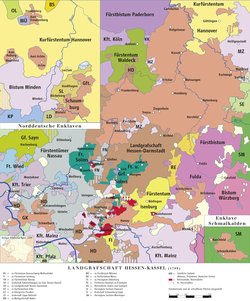Hesse-Cassel
| Landgraviate of Hesse-Kassel | ||||||||||
| Landgrafschaft Hessen-Kassel | ||||||||||
| State of the Holy Roman Empire | ||||||||||
|
||||||||||
|
Hesse-Kassel in 1789
|
||||||||||
| Capital | Kassel | |||||||||
| Languages | German, Hessian | |||||||||
| Religion |
|
|||||||||
| Government | Absolute monarchy | |||||||||
| Landgrave | ||||||||||
| • | 1567–1592 | William IV | ||||||||
| • | 1730–1751 | Frederick I, King of Sweden | ||||||||
| • | 1751–1760 | William VIII | ||||||||
| • | 1760–1785 | Frederick II | ||||||||
| • | 1785–1803 | William IX (Elector of Hesse to 1821) | ||||||||
| History | ||||||||||
| • | Established | 1567 | ||||||||
| • | Raised to Electorate | 1803 | ||||||||
|
||||||||||
| Today part of |
|
|||||||||
The Landgraviate of Hesse-Kassel (German: Landgrafschaft Hessen-Kassel), known as Hesse-Cassel during its existence, was a state in the Holy Roman Empire directly subject to the Emperor that came into existence when the Landgraviate of Hesse was divided in 1567 upon the death of Philip I, Landgrave of Hesse.
His eldest son William IV inherited the northern half and the capital of Kassel. The other sons received the Landgraviate of Hesse-Marburg, the Landgraviate of Hesse-Rheinfels and the Landgraviate of Hesse-Darmstadt.
The Landgrave of Hesse-Kassel was elevated to the Electorate of Hesse and Landgrave William IX was elevated to Imperial Elector during the reorganization of the Empire in 1803, in the midst of the Napoleonic wars, and later occupied by French troops and became part of the Kingdom of Westphalia, which was a French satellite state.
The line of Landgraves was founded by William IV, surnamed the Wise, the eldest son of Philip I. On his father's death in 1567, he received one half of the Landgraviate of Hesse, with Kassel as his capital; and this formed the Landgraviate.
...
Wikipedia


